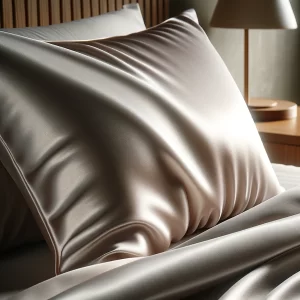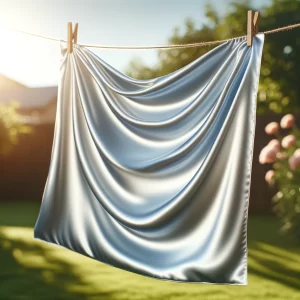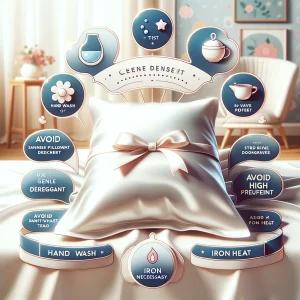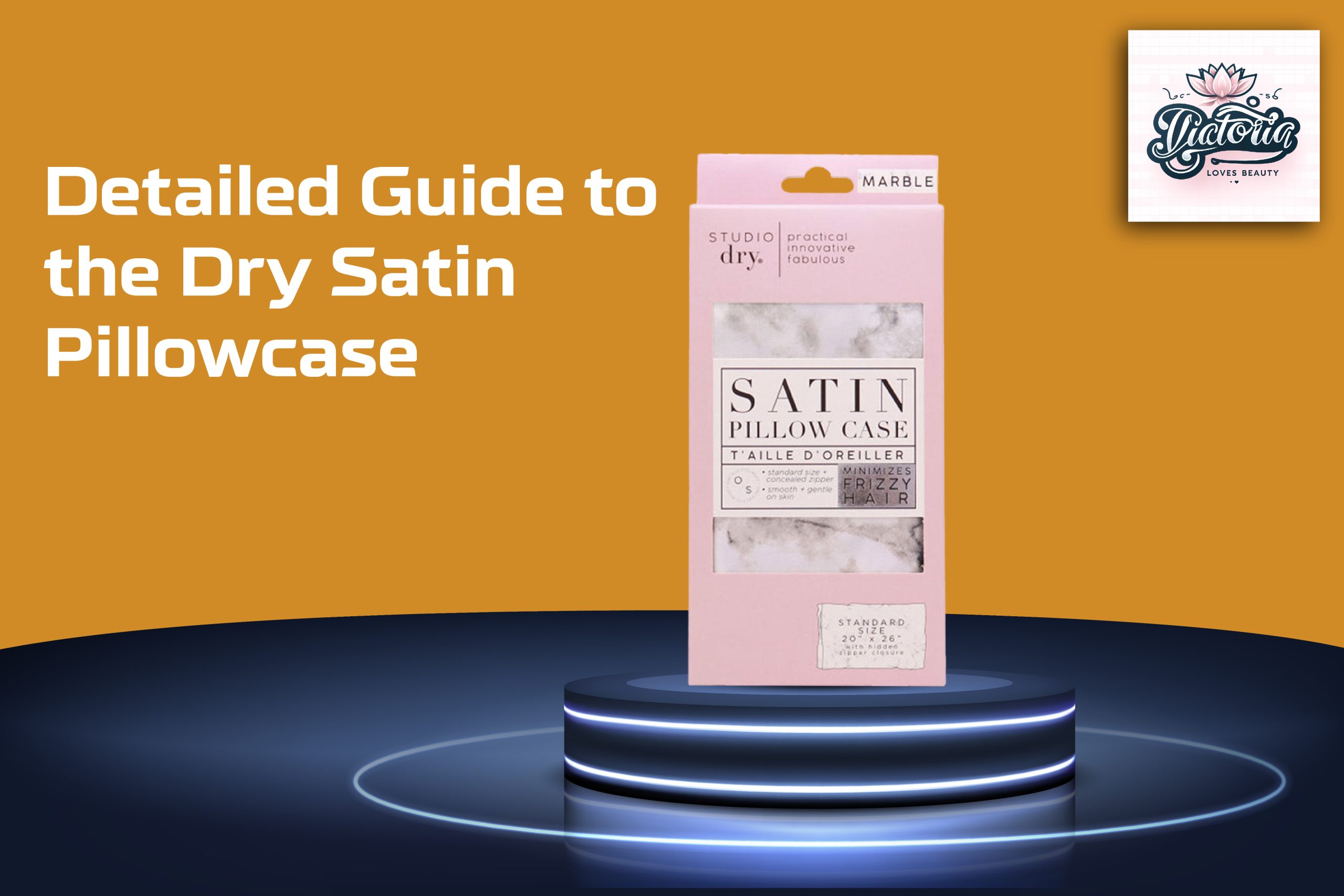Dry Satin Pillowcase
The little things often define luxury in the bedroom, and satin pillowcases are one of those small luxuries that can make a big difference. Not only do they feel wonderfully smooth against your skin, but they also help keep your hair frizz-free and smooth. However, the key to maintaining their luxurious feel and appearance is how you care for them, particularly when drying.

Satin, often made from silk, polyester, or a blend, requires special care due to its delicate nature. Incorrect drying methods can lead to problems such as loss of sheen, weakening of fibers, and even permanent damage. Thus, it’s essential to understand the proper techniques to dry satin pillowcases to preserve their quality and prolong their life.
Caring for satin pillowcases might seem like extra work, but paying for the luxury they bring to your sleep experience is a small price. Remember, the key is gentle care – gentle washing, drying, and, if needed, gentle ironing. By following these simple steps, you can ensure that your satin pillowcases remain as sumptuous as the day you bought them.
Congratulations on successfully washing your satin pillowcase! Let’s ensure it retains its elegance and softness as it dries. Here’s how:

Handle with Care: Avoid Twisting and Wringing
especially when dealing with delicate materials like silk, satin, or wool; the mantra “Handle with Care” cannot be emphasized enough. One crucial aspect of this careful handling is avoiding two common but harmful practices: twisting and wringing. Let’s dive into why these practices are damaging and explore better alternatives to ensure the longevity and beauty of your delicate garments. After washing, never wring or twisting your satin pillowcase. Satin, especially when wet, is prone to stretching and warping due to its elastic fibers. Handle your pillowcase gently to maintain its shape and integrity.
Proper care of delicate fabrics is vital to maintaining their beauty and longevity. By avoiding twisting and wringing and opting for gentler water removal and drying methods, you can ensure your delicate garments remain pristine for years. Remember, treating your delicate items with the care they deserve will keep them looking as luxurious as they feel.
The Dryer Debate: To Use or Not to Use?
Generally, it’s best to avoid the dryer for satin pillowcases. Even on a gentle, no-heat cycle, a dryer can twist or stretch the fabric, potentially leading to shrinkage or pilling. However, if you choose to use a dryer, opt for a low-heat setting and remove the pillowcase promptly to reduce these risks. Using a clothes dryer has always been debated, especially regarding certain fabrics and garments. While the convenience of a dryer is undeniable, it’s essential to weigh the pros and cons to decide whether to air-dry or tumble-dry your clothes. Let’s explore the factors that contribute to this debate. The decision to use a dryer depends on various factors, including the type of fabric, energy considerations, and personal preference. While dryers offer convenience and quick drying, air drying is gentler on clothes and more energy-efficient. Balancing these factors and following the care instructions on your garments will ensure their longevity and appearance. Ultimately, the “dryer debate” boils down to a mix of practicality and garment care.
Air Drying: The Preferred Method
Air drying is often the safest choice for your satin pillowcase. If you’ve hand-washed it, lay it on a clean, dry, white towel and gently roll out the water. Repeat with a new towel until it feels just damp. Then, lay the pillowcase flat on a surface away from direct heat to dry completely. This method helps preserve the fabric’s quality and prevents stretching or misshaping. Air drying stands out as a preferred method for many reasons. It’s gentle on fabrics, environmentally friendly, and can help preserve the quality and longevity of your clothes. Let’s explore why air drying is often the better choice and how to make the most of it. Air drying is a simple, cost-effective, and fabric-friendly method that aligns with environmentally conscious practices. By air drying your laundry, you’re not only taking care of your clothes but also making a positive impact on the environment.
Hanging on a Clothesline: Proceed with Caution
Hanging clothes on a clothesline is a time-honored tradition and an eco-friendly way to dry laundry. However, it has its nuances. To ensure your garments stay in good condition, it’s essential to understand the do’s and don’ts of using a clothesline. Here’s a guide to help you proceed with caution and care. Hanging your laundry on a clothesline is a great way to save energy and enjoy the benefits of air-dried clothes. Following these guidelines can avoid common pitfalls and ensure your garments stay in good condition. If you opt for hanging, be mindful of the material. Silk or wool satin pillowcases might stretch under their weight on a clothesline. Polyester satin is more suitable for hanging, but check the care tag first – some may advise laying flat to dry.
Laying Flat: A Safe Bet
Lay your satin pillowcase flat to dry on a fluffy towel when in doubt. This approach is gentle and effective, allowing for even drying without risking damage to the fabric. Flat drying is a simple yet effective method to preserve the quality and longevity of delicate and stretch-prone garments. By laying your clothes flat to dry, you can avoid many pitfalls associated with other drying methods, ensuring your favorite pieces stay in perfect shape for years. It’s a small effort that can make a big difference in your wardrobe maintenance.
Finishing Touches: Snap and Steam for Perfection
Once your clothes are clean and dry, the final step in achieving that crisp, fresh-from-the-laundry look is often in the finishing touches. Two essential techniques – snapping and steaming – can elevate the appearance of your garments, ensuring they look their best. Here’s how to incorporate these finishing touches into your laundry routine for perfect results. Once dry, gently snap your satin pillowcase to fluff up the fibers and restore its softness. If any wrinkles have formed, a light steaming can smooth them out without harming the fabric. Incorporating snapping and steaming into your post-laundry routine can dramatically improve the look and feel of your clothes. These techniques are simple yet effective ways to ensure your garments are clean and impeccably maintained. With these final touches, you’re all set to step out in style, adorned in clothes that radiate care and attention.
Conclusion
Caring for your satin pillowcase correctly is critical to maintaining its luxurious quality. Whether you opt for air drying, using a dryer in a gentle setting, or laying it flat, the proper technique will ensure that your pillowcase remains soft, wrinkle-free, and beautiful for longer. Always handle your satin gently, and it will continue to provide you with comfortable, luxurious sleep night after night. We’ve journeyed through essential techniques and best practices, particularly the delicate art of washing and drying items like satin pillowcases and other sensitive materials. From understanding the importance of gentle washing to mastering the art of air-drying and avoiding common pitfalls like twisting and wringing, each step has been a crucial part of maintaining the integrity and beauty of our delicate fabrics.
We’ve discussed the nuances of using a dryer, the advantages of laying flat to dry, and the benefits of traditional methods like hanging clothes on a clothesline. We’ve also seen how finishing touches like snapping and steaming can add a final flourish, ensuring our garments are clean, well-maintained, and presentable.
This guide has been more than just a series of instructions; it’s been a testament to the care and attention we should give to our belongings. Practicing these methods, we preserve our fabrics, contribute to sustainable living, and extend the life of our cherished items.
As we conclude, remember that how we care for our clothes reflects our respect for the things we own and our world. It’s a small but significant part of our daily lives that underscores the importance of mindfulness and responsibility. So, let’s continue to care for our garments with the attention and respect they deserve, ensuring they last longer and bring us joy and comfort in our everyday lives.
You Need to Know

Q: Can I use a dryer for my satin pillowcase?
A: Using a dryer on a satin pillowcase is not advisable. Satin is a fragile fabric that can be easily harmed by a dryer’s intense heat and tumble motion, whether composed of silk, polyester, or a combination. It is typically recommended to avoid using the dryer. If you must use one, use a low-heat setting and remove the pillowcase as soon as possible to reduce the chance of damage. It is strongly advised against using a dryer on your satin pillowcase. However, if necessary, use the lowest heat setting allowed and remove the pillowcase from the dryer as soon as possible to avoid any potential harm to this fragile fabric.
Q: How do I prevent my satin pillowcase from wrinkling?
A: Preventing wrinkles in your satin pillowcase can help maintain its smooth and luxurious appearance to keep the sanitation pillow for the proper wash. The generation of pillows has a different form, placed in different forms in different sanitation. You can follow the different sanitation of the place that will allow you to have different places with the proper washing the mess laundry and have a different form of the overlying the lowest setting or even a better, air-drying the different pillow case for leading the wrinkles and loss of sheen. To prevent stained pillowcases from wrinkling, you can wash them properly, avoid over-drying, remove them promptly, store them properly, iron them carefully, and rotate them. Lay the pillowcase flat on a towel to dry, and use light steam to remove any wrinkles afterward.
Q: Can I hang my satin pillowcase to dry?
A: Yes, but be cautious with silk or wool satin as they can stretch. Polyester satin is more suitable for hanging but always check the care tag first. You hang your satin pillowcase to dry, and in fact, it’s a recommended method for drying satin. Hanging it on a clothesline or a drying rack is a gentle way to dry the pillowcase without subjecting it to a dryer’s high heat and tumbling action. To avoid creases, gently shake the pillowcase before hanging it, and ensure it’s in a well-ventilated area. Hanging your satin pillowcase to dry will help preserve its smooth and luxurious texture
Q: Is it okay to wring out my satin pillowcase to remove excess water?
A: Wing out your satin pillowcase. It is not advisable to eliminate extra water. Satin is a fragile fabric that can become distorted, stretched, or damaged if wrung. Instead, gently press your satin pillowcase between two clean towels to absorb extra moisture without harming it. Then, lay it flat or hang it to air dry. This moderate technique will help your satin pillowcase retain its quality and look. Wringing and twisting can strain and deform the satin. Following these instructions and advice will guarantee that your satin pillowcases are well-cared for and retain their rich feel and appearance.

Beauty enthusiast, mom on-the-go, and coffee addict (not necessarily in that order!). When she’s not chasing after her adorable toddler, Victoria is busy researching the latest beauty trends, testing out products, and sharing her discoveries with the world. Join her on this journey of self-care, empowerment, and finding your own unique spark of beauty!
